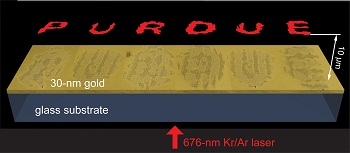
To demonstrate the metasurface hologram technology, researchers created a hologram of the word PURDUE smaller than 100 microns wide, or roughly the width of a human hair. Xingjie Ni, Birck Nanotechnology Center, Purdue University.
In recent years, researchers have used metamaterials to bend light in ways not found in nature and even make objects disappear from view. Now, a team from Purdue University (Indiana, U.S.A.) has used a tiny-patterned “metasurface” to create ultra-thin red-light holograms (Nature Commun. 4, 2807).
The metasurface designed by researchers at Purdue's Birck Nanotechnology Center consists of nanosized perforations into a 30-nm-thick gold layer on a glass substrate. The subwavelength-scale voids, shaped with a focused ion beam, act as tiny plasmonic antennas to control the phase of the 676-nm laser light beamed through the metasurface.
The voids, roughly 150 x 150 nm, are arranged in a pattern that to the naked eye does not resemble the holographic image they generated. However, when the scientists beam the laser light up through the metasurface hologram, the desired image appears in a plane 10 μm above it (see image).
According to Purdue researchers Xingjie Ni (now at the University of California, Berkeley), Alexander Kildishev and OSA Fellow Vladimir Shalaev, the metasurface hologram could lead to more compact optical components in planar optical systems, displays and future nanophotonic devices.
